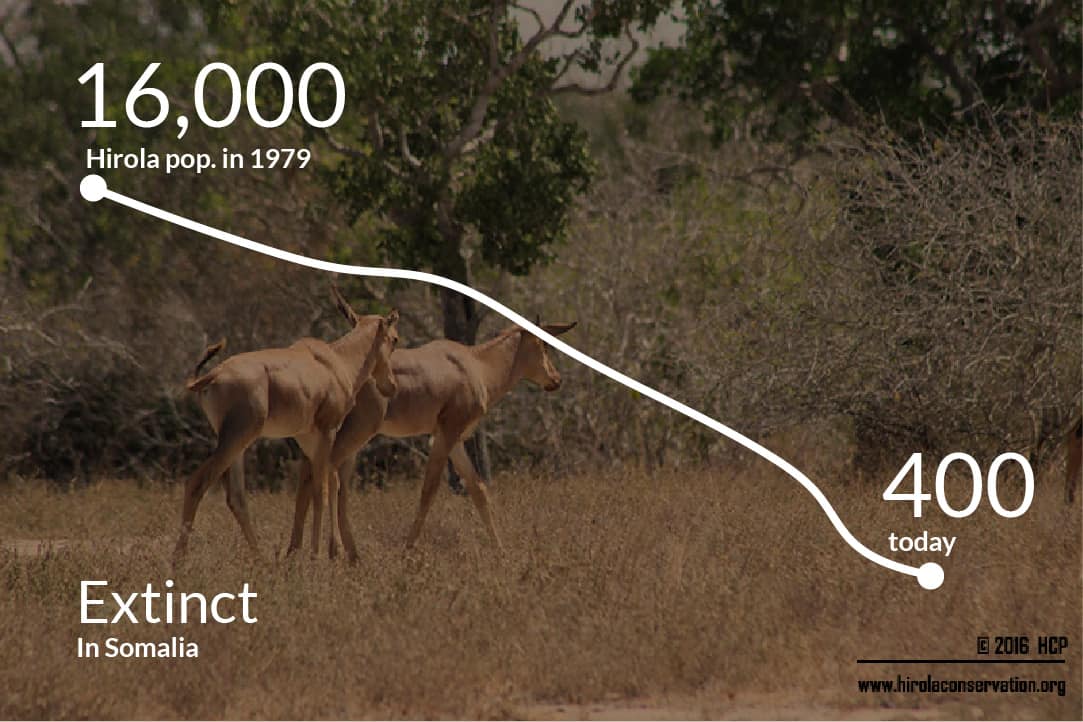Species scientific or Latin name(s): Beatragus hunteri
Common name: Hirola
IUCN Conservation status: Critically endangered
The Hirola is endemic to north-east Kenya and south-west Somalia. Historical distribution is estimated to have covered ca. 17,900 km in Kenya and ca. 20,500 km in Somalia. In Kenya, hirola, currently occur between Ijara, Bura and GalmaGalla over an area of ca. 1200 km. Current status in south-west Somalia is not known, but its former range has been badly affected by prolonged civil and military conflicts that is currently ongoing for over two decades. There is a small translocated population in Tsavo East National Park, outside the species natural range. This originated from a translocation of 30 animals from Garissa District conducted in 1963. It is thought that most of these perished soon after release and that the size of the effective founder population was only 11 to 19 animals. A further 10 animals were translocated to Tsavo East in 1996.
In 1979, there were ca. 16,000 animals in Kenya on 17,900 km. Estimated numbers decreased from 12,500 in the early to mid-1970s to about 7,000 in 1977-83, followed by a drastic decline (85 to 90%) between 1983 and 1985 caused by the severe drought of 1984. Ground surveys suggested a population of between 500 and 2,000 in Kenya in 1995/1996 and the latest aerial survey in 2011 estimated hirola to be between 245-400 individuals.In the absence of management intervention, the population is projected to dwindle to fewer than 20 individuals over the next 50 years and global extinction is predicted within the next 100 years.
Hirola inhabit semi-arid thorn bush, open bush grassland, to light woodland, and lush savanna grassland. Their preferred habitat is seasonally flooded, open grassland with scattered small shrubs and trees underlined by well-drained soils with short leafy swards of grass maintained by the combined grazing pressure of fire, wildlife and domestic livestock.
A combination of habitat degradation, competition with livestock, and disease are responsible for historic declines, with habitat degradation and predation combining to suppress contemporary populations. The Tsavo population additionally faces predation by relatively high densities of large carnivores and competition from a greater variety of other wild herbivore species (but much lower numbers of cattle) than in its natural range
- Site/area protection
- Site/area management
- Species recovery
- Species re-introduction
- In-situ conservation
- Awareness & communications
Ongoing field Conservation Actions
Some of the ongoing conservations include: habitat restoration, field based breeding programme, anti-poaching, protected area management and protection,and future re-introduction efforts. The long-term recovery and management of the hirola population is hinged on addressing the threats responsible for the ongoing population declines. Therefore, hcp is undertaking habitat restoration, anti-poaching efforts, and community conservancies management and the reinstatement of Arawale national Reserve. In addition, we have a longterm community education and outreach programme targeting Somali pastoralists, indigenous communities and school-going children within the hirola’s geographic range.

